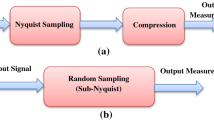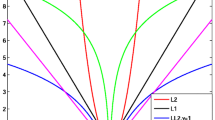Abstract
The sparse signal recovery is of great interest in compressed sensed data recovery. Many sparse recovery algorithms were developed in the last decade. However, selection of an appropriate recovery algorithm is an important matter of concern in many applications. The recovery algorithms are generally compared in terms of computational complexity, computational time, recovery probability and recovery precision. Typically, absolute Mean Squared Error (MSE) and relative MSE are used to compare the recovery precision of various sparse recovery algorithms. However, these two metric alone may not qualify to assess all algorithms. This paper presents an algorithm evaluation strategy by ranking the algorithms concerning an observable similarity between the original and reconstructed signal. We aim to propose a recovery similarity measure and an empirically defined factor to compare the performance measure of sparse recovery algorithms.










Similar content being viewed by others
References
Maia, Qing, Zou, Hui: Sparse semiparametric discriminant analysis. J. Multivar. Anal. 135, 175–188 (2015)
Zhang, Z., Xu, Y., Yang,J., Li, X., Zhang, D.: A survey of sparse representation: algorithms and applications. IEEE Access (2015)
Donoho, D.L.: Compressed sensing. IEEE Trans. Inf. Theory 52, 1289–1306 (2006)
Yuan, X., Haimi-Cohen, R.: Image compression based on compressive sensing: end-to-end comparison with JPEG. IEEE Trans. Multimed. 22, 2889–2904 (2020)
Crespo Marques, E., Maciel, N., Naviner, L., Cai, H., Yang, J.: A review of sparse recovery algorithms. IEEE Access 7, 1300–1322 (2019)
Steffen, P.: Algorithms for Robust and Fast Sparse Recovery, New approaches towards the noise folding problems and the big data challenge, Thesis, Technical University of Munich (2016)
Candes, E.: The restricted isometry property and its implications for compressed sensing. Compte. Rendus Math. C. R. Acad. Sci. Paris Ser. I 346, 589–592 (2008)
DeVore, R.: Deterministic constructions of compressed sensing matrices. J. Complex. 23, 918–925 (2007)
Blanchard, J.D., Cermak, M., Hanle, D., Jing, Y.: Greedy algorithms for joint sparse recovery. IEEE Trans. Signal Process. 62, 1694–1704 (2014)
Tropp, J.A., Gilbert, A.C.: Signal recovery from random measurements via orthogonal matching pursuit. IEEE Trans. Inf. Theory 53, 4655–4666 (2007)
Tong, Z., Wang, F., Hu, C., et al.: Preconditioned generalized orthogonal matching pursuit. EURASIP J. Adv. Signal Process. 21, 1 (2020)
Needell, D., Tropp, J.A.: CoSaMP: iterative signal recovery from incomplete and inaccurate samples. Appl. Comput. Harmonic Anal. 26, 301–321 (2008)
Zhang, Y.: User’s Guide for YALL1: Your ALgorithms for L1 Optimization (2009)
Hai-Rong, Y., Hong, F., Zhang, C., Sui, W.: Iterative hard thresholding algorithm based on backtracking. Acta Automatica Sinica. 37, 276–282 (2011)
Beck, A., Teboulle, M.: A fast iterative shrinkage thresholding algorithm for linear inverse problems. SIAM J. Imag. Sci. 2, 183–202 (2009)
Gill, P.E., Robinson, D.P.: A primal-dual augmented Lagrangian. Comput. Optim. Appl. 51, 1–25 (2012)
Becker, Stephen, Bobin, Jérôme., Candès, Emmanuel J.: NESTA: a fast and accurate first-order method for sparse recovery. SIAM J. Imag. Sci. 4(1), 1–39 (2011)
Vidya, L., Vivekanand, V., Shyam, Kumar U., Mishra, D.: RBF-network based sparse signal recovery algorithm for compressed sensing reconstruction. Elsevier Neural Netw. 63, 66–78 (2015)
Mohimani, G.H., Zadeh, M.B., Jutten, C.: A fast approach for overcomplete sparse decomposition based on smoothed L0 norm. IEEE Trans. Signal Process. 57, 289–301 (2009)
Vivekanand, V., Vidya, L.: Compressed sensing recovery based on polynomial approximated \(l_{0}\) minimization of signal and error: XEL0. In: Proc. IEEE SPCOM Conf. Bangalore, India (2014)
Daubechies, I., DeVore, R., Fornasier, M., et al.: Iterative re-weighted least squares minimization for sparse recovery. Comm. Pure. Appl. Math. 63, 1–38 (2010)
Chen, S.B., Donoho, D.L., Saunders, M.A.: Atomic decomposition by basis pursuit. SIAM J. Sci. Comput. 20, 33–61 (1998)
Tibshirani, R.: Regression shrinkage and selection via the lasso. J. R. Stat. Soc. B. 58, 267–288 (1996)
Asif, M.S., Romberg, J.: Fast and accurate algorithm for reweighted \(\ell _{1}\) norm minimization. IEEE Trans. Signal Process. 61, 5905–5916 (2012)
Vila, Jeremy, Schniter, Philip: Expectation-Maximization Gaussian-Mixture Approximate Message Passing. IEEE Trans. Signal Processing 61, 4658–4672 (2013)
Joseph, Geethu, Murthy, Chandra: A non-iterative online Bayesian algorithm for the recovery of temporally correlated sparse vectors. IEEE Trans. Signal Process. 65, 5510–5525 (2017)
Fan, J., Li, R.: Variable selection via nonconcave penalized likelihood and its oracle properties. J. Am. Stat. Assoc. 96, 1348–1360 (2001)
Mehranian, A., Saligheh Rad, H., Ay, M.R., Rahmim, A., Zaidi, H.: Smoothly clipped absolute deviation (SCAD) regularization for compressed sensing MRI using an augmented Lagrangian scheme. IEEE NSS/MIC CA, USA, pp. 3646-3653 (2012)
Mohammadi, M.M., Koochakzadeh, A., Zadeh, M.B., Jansson, M., Rojas, C.R.: Successive concave sparsity approximation for compressed sensing. IEEE Trans. Signal Process. 64, 5657–5671 (2016)
Ghayem, F., Sadeghi, M., Babaie-Zadeh, M., Chatterjee, S., Skoglund, M., Jutten, C.: Sparse signal recovery using iterative proximal projection. IEEE Trans. Signal Process. 66, 879–894 (2018)
Castro, E.A., Eldar, Y.C.: Noise Folding in Compressed Sensing. IEEE Sig. Process. Lett. 18, 478–481 (2011)
Herman, M.A., Strohmer, T.: General deviants: an analysis of perturbations in compressed sensing. IEEE J. Sel. Top. Signal Process. (2010)
Acknowledgements
The authors would like to acknowledge the authors of different algorithms for their support in the implementation of the algorithms using MATLAB. The research on sparse recovery algorithms has been made possible using the facility available at Indian Institute of Space Science and Technology, Vikram Sarabhai Space Centre and Indian Space Research Organisation.
Funding
The research on sparse recovery algorithms is supported by Indian Space Research Organisation, Government of India. Conflict of Interest: None of the authors of this manuscript has conflict of interest with any of the matter or materials discussed in the document. Data Availability: The data and simulation code used in the illustration are available up on request. Code Availability: The algorithm is developed used MATLAB software and is available on request.
Author information
Authors and Affiliations
Corresponding author
Additional information
Publisher's Note
Springer Nature remains neutral with regard to jurisdictional claims in published maps and institutional affiliations.
Rights and permissions
Springer Nature or its licensor holds exclusive rights to this article under a publishing agreement with the author(s) or other rightsholder(s); author self-archiving of the accepted manuscript version of this article is solely governed by the terms of such publishing agreement and applicable law.
About this article
Cite this article
Vivekanand, V., Mishra, D. Performance measure for sparse recovery algorithms in compressed sensing perspective. Int J Data Sci Anal 15, 391–406 (2023). https://doi.org/10.1007/s41060-022-00357-6
Received:
Accepted:
Published:
Issue Date:
DOI: https://doi.org/10.1007/s41060-022-00357-6




